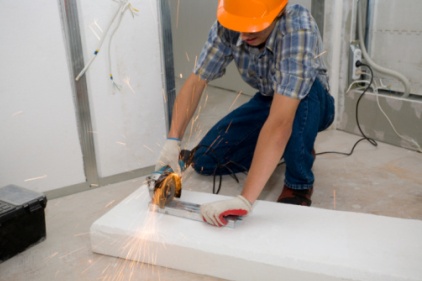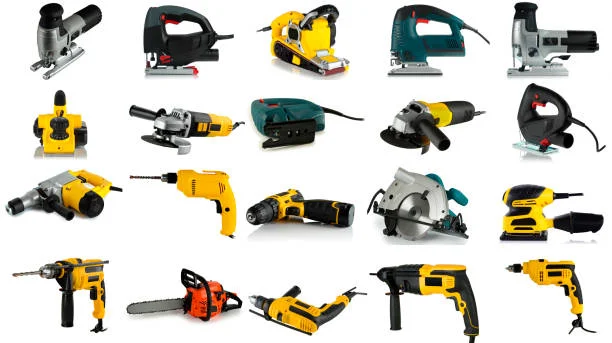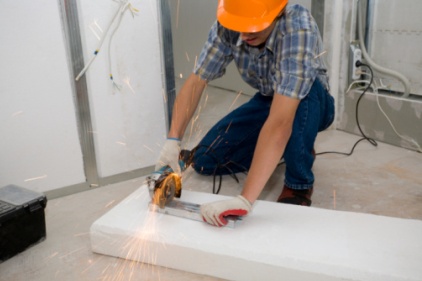Did you know that power tools can be incredibly helpful when it comes to getting things done? From drilling holes to cutting materials, power tools make our tasks much easier. But, just like any tool, they also come with their own set of hazards. So, what are the hazards of using power tools? Let’s find out!
When it comes to using power tools, safety should always be the top priority. One hazard to be aware of is the risk of electrical shock. Power tools are powered by electricity, which means there is always a chance of coming into contact with live wires. Another hazard is the potential for cuts and lacerations. Power tools have sharp blades and fast-moving parts that can easily cause injuries if not used properly.
In addition to the risk of electrical shock and cuts, power tools can also create loud noises and vibrations, which can lead to hearing loss and hand-arm vibration syndrome. It’s important to use ear protection and take breaks to minimize the impact on your hearing and body. So, before you start using power tools, make sure you understand and follow all safety guidelines to reduce the risk of accidents and injuries. Stay safe and enjoy the benefits of power tools!

The Hazards of Using Power Tools: What You Need to Know
Power tools can be incredibly useful and efficient in completing various tasks, whether it’s a small DIY project or a professional construction job. However, it’s important to be aware of the hazards that come with using these tools. In this article, we will explore the potential dangers of power tools and provide valuable information to help you stay safe while using them.
Electrocution: A Shocking Hazard
One of the most significant hazards when working with power tools is the risk of electrocution. Many power tools are powered by electricity, and if not handled properly, they can cause severe electrical shocks. Faulty wiring, damaged cords, or using a tool while standing on wet surfaces can all increase the chances of electrocution. It’s crucial to always inspect your power tools and cords for any damage before use and to use proper electrical safety measures.
In addition to inspecting your tools, it’s important to properly ground them and use ground-fault circuit interrupters (GFCIs) to prevent electrical shocks. GFCIs are designed to quickly cut off power in case of an electrical fault, minimizing the risk of injury. Always make sure to familiarize yourself with the safety guidelines provided by the tool’s manufacturer and follow them diligently.
It’s worth noting that electrical hazards can occur not only during the operation of power tools but also during the maintenance, storage, or repair process. Always unplug the tool when not in use, store it in a dry and secure place, and never attempt to repair a power tool without proper knowledge and training.
Noise-Induced Hearing Loss: Protect Your Ears
Power tools are known for their noisy operation, and prolonged exposure to loud noise can lead to hearing damage or even permanent hearing loss. Tools such as drills, saws, or jackhammers can generate high decibel levels that exceed the safe threshold for human hearing. Even if the noise doesn’t seem bothersome at the moment, repeated exposure without proper hearing protection can have long-term consequences.
When using power tools, always wear hearing protection such as earmuffs or earplugs to reduce the impact of noise on your ears. Make sure the hearing protection you choose is appropriate for the noise level generated by the tool you are using. It’s also vital to take regular breaks from using noisy tools and give your ears a chance to rest.
Education and awareness are key in preventing noise-induced hearing loss. Familiarize yourself with the safe exposure limits for noise, recognize the symptoms of hearing damage, and consult a healthcare professional if you experience any issues with your hearing.
Eye Injuries: Shielding Your Vision
Power tools often produce debris, sparks, or airborne particles during operation, posing a significant risk to your eyes. Without proper eye protection, you are susceptible to eye injuries such as corneal scratches, foreign object penetration, or even permanent damage to your vision.
Always wear safety glasses or goggles that meet the industry’s safety standards when working with power tools. Eyewear with side shields provides extra protection from debris coming from different angles. Face shields can also be used in situations where the risk of larger debris or liquid splashes is higher.
Moreover, it’s essential to maintain a clean and well-illuminated work area to enhance visibility and reduce the chances of accidents. Regularly inspect your safety eyewear for any damage and replace it if necessary. Remember, protecting your eyes should be a top priority when working with power tools.
Respiratory Hazards: Breathing Easy with the Right Protection
Some power tools, such as sanders or grinders, produce fine dust or particles that can be harmful when inhaled. These airborne contaminants may include wood dust, metal shavings, or chemicals, depending on the task at hand. Prolonged exposure to these hazardous substances can lead to respiratory conditions such as occupational asthma, lung diseases, or other respiratory impairments.
To protect your respiratory system, it’s crucial to use appropriate personal protective equipment (PPE) such as respirators or masks that filter out the harmful particles. The type of respiratory protection needed depends on the specific hazardous substances involved and their concentration in the air. Make sure to consult the safety guidelines and material safety data sheets (MSDS) for the products you are working with to determine the appropriate respiratory protection.
Additionally, keeping your work area well-ventilated and using dust collection systems or exhaust fans can help minimize the buildup of airborne particles. Regularly clean and maintain your power tools to prevent dust accumulation and reduce the risk of respiratory hazards.
Dangerous Amputations: Keeping Your Limbs Safe
Power tools that involve sharp blades or rotating parts pose a significant risk of amputation or severe cuts if not used properly. Tools such as table saws, circular saws, or angle grinders can cause life-altering injuries if caution is not exercised.
Always read the manufacturer’s instructions and familiarize yourself with the proper handling techniques for each power tool. Use appropriate guards and safety mechanisms provided with the tool to prevent accidental contact with the blades or moving parts. Never wear loose clothing or jewelry that can get caught in the tool, and always maintain a firm grip on the tool while operating it.
In addition to using proper technique, maintaining a clear work area free from distractions is essential. Ensure that bystanders are at a safe distance and avoid working when you are tired or distracted. Remember, it only takes a momentary lapse in concentration for a severe injury to occur.
Chemical Exposure: Safely Handling Hazardous Substances
Some power tools, especially those used in painting, woodworking, or automotive applications, may involve the use of hazardous substances such as paints, solvents, or adhesives. Chemical exposure can lead to various health effects, ranging from skin irritation to respiratory problems or long-term organ damage.
Always read the safety data sheets (SDS) for the chemicals you are working with and follow the recommended safety precautions. Wear appropriate gloves, protective clothing, and respiratory protection when handling and applying hazardous substances. It’s important to work in a well-ventilated area or use respiratory protection to avoid breathing in harmful vapors or fumes.
Cleaning up spills or disposing of hazardous substances should also be done following proper safety protocols. Use designated containers for waste disposal and ensure that they are stored in a secure area away from ignition sources.
Falls and Trips: Maintaining Stability and Balance
Working with power tools often involves tasks that require climbing ladders, working on scaffolding, or operating at elevated heights. Falls and trips can lead to severe injuries, making it crucial to practice proper safety measures to maintain stability and balance.
Always use stable and properly maintained equipment when working at heights. Inspect ladders or scaffolding for any damage or defects and make sure they are set up on level ground. Utilize fall protection equipment such as harnesses, safety nets, or guardrails when necessary. Additionally, wearing appropriate footwear with slip-resistant soles can help prevent slips and trips on different surfaces.
Adhering to a comprehensive fall prevention program and conducting regular safety inspections can significantly reduce the risk of falls and trips while working with power tools.
Tips for Ensuring Safety with Power Tools
Now that you are aware of the hazards associated with power tool use, let’s explore some essential tips to ensure maximum safety:
1. Educate Yourself:
Take the time to thoroughly read the instruction manuals and safety guidelines provided by the tool manufacturer. Know the potential hazards associated with each tool and how to mitigate them.
2. Wear Appropriate PPE:
Always use the necessary personal protective equipment, such as safety glasses, hearing protection, respiratory protection, and appropriate clothing. Ensure that your PPE fits properly and is in good condition.
3. Inspect Tools and Cords:
Regularly inspect your power tools, cords, and plugs for any damage or wear. Replace or repair them as needed to prevent electrical hazards or malfunctions during use.
4. Use the Right Tool for the Job:
Each power tool is designed for specific tasks. Use the appropriate tool for the job to ensure efficiency and safety. Using a tool for tasks it was not intended for can lead to accidents and damage to both the tool and the workpiece.
5. Maintain a Clean and Organized Work Area:
A cluttered or messy workspace can increase the risk of accidents. Keep your work area clean, well-illuminated, and free from tripping hazards.
6. Take Breaks:
Working with power tools for extended periods can lead to fatigue and decreased focus, increasing the likelihood of accidents. Take regular breaks to rest and recharge.
7. Seek Professional Help if Unsure:
If you are unsure about the safe use of a power tool or if a tool requires repair or maintenance, consult a professional or seek assistance from someone with expertise in the field.
Power Tools and Your Safety: A Lasting Partnership
While power tools offer convenience and efficiency, it’s important to remember that safety should always come first. By being aware of the hazards associated with power tool use and implementing the necessary safety measures, you can confidently complete your projects without compromising your well-being. Keep learning, stay vigilant, and make safety a priority in your power tool endeavors.
Key Takeaways – Hazards of Using Power Tools
- 1. Power tools can cause serious injuries if not used correctly.
- 2. Always wear appropriate safety gear like goggles and gloves.
- 3. Keep work areas clean and organized to avoid accidents.
- 4. Never operate power tools when tired or under the influence of drugs or alcohol.
- 5. Regularly inspect and maintain power tools for safety.
Frequently Asked Questions
Welcome to our frequently asked questions section on the hazards of using power tools. Whether you’re a seasoned DIY enthusiast or a beginner, it’s crucial to understand the potential dangers associated with power tools. Read on to find answers to some commonly asked questions regarding power tool hazards.
What are some common hazards of using power tools?
Power tools can be incredibly useful, but they also pose various risks. Some common hazards include:
1. Electrical shock: Power tools are powered by electricity, making electrical shock a significant risk if proper precautions are not taken.
2. Accidental cuts and lacerations: The sharp edges and moving parts of power tools can cause severe cuts if not used with caution.
3. Noise-induced hearing loss: Power tools can emit loud noise, which can lead to permanent hearing damage if adequate hearing protection is not worn.
4. Eye injuries: Flying debris, sparks, or loose materials can cause severe eye injuries when using power tools without protective eyewear.
5. Inhalation of harmful substances: Some power tools generate dust, fumes, or other hazardous substances, which, if inhaled, can lead to respiratory problems.
To prevent these hazards, always wear appropriate personal protective equipment, follow the manufacturer’s instructions, and ensure the workspace is well-lit and properly ventilated.
How can I reduce the risk of electrical shock when using power tools?
To minimize the risk of electrical shock while using power tools, follow these guidelines:
1. Use tools with grounded electrical cords or double-insulated tools to avoid direct contact with live wires.
2. Regularly inspect power tool cords for any signs of damage or exposed wires and replace them if necessary.
3. Always use a ground fault circuit interrupter (GFCI) when working with power tools in wet or damp areas.
4. Keep power tools away from water sources, and never operate them with wet hands or in wet conditions.
5. Ensure your work area has proper grounding and use power outlets equipped with ground-fault protection.
By practicing these safety measures, you can significantly reduce the risk of electrical shock when using power tools.
What types of personal protective equipment (PPE) should I use when using power tools?
When operating power tools, it’s essential to wear the appropriate personal protective equipment (PPE) to minimize the risk of injuries. Some commonly used PPE for power tool usage includes:
1. Safety goggles: Protect your eyes from flying debris, sparks, or dust.
2. Ear protection: Use earmuffs or earplugs to reduce the risk of hearing damage caused by loud power tools.
3. Gloves: Wear gloves to protect your hands from cuts, lacerations, or burns when working with power tools.
4. Respirators or masks: When working with tools that generate dust, fumes, or chemicals, wear respiratory protection to prevent inhalation of harmful substances.
5. Steel-toed boots: Protect your feet from falling objects or accidental impacts while using power tools.
Choosing the appropriate PPE for the specific power tool and task at hand is essential to ensure your safety while working.
How should I store and maintain my power tools to prevent accidents?
Proper storage and maintenance of power tools are crucial for preventing accidents. Here are some guidelines to follow:
1. Store power tools in a dry and secure location, away from children’s reach.
2. Keep power cords neatly coiled and away from heat sources or sharp objects to prevent damage.
3. Regularly inspect power tools for any signs of wear, damage, or loose parts. If any issues are detected, have them repaired or replaced.
4. Clean power tools after each use, removing any debris or buildup that may affect their performance.
5. Follow the manufacturer’s instructions for maintenance, including lubricating moving parts and replacing worn-out components.
By storing and maintaining your power tools properly, you can extend their lifespan and ensure safe and efficient operation.
Are there any safety guidelines specifically for using power tools at home?
When using power tools at home, it’s crucial to follow some additional safety guidelines:
1. Create a designated workspace free of clutter, tripping hazards, and distractions.
2. Use a power strip with a built-in circuit breaker to prevent electrical overload and reduce the risk of fire.
3. If you have children or pets, secure the workspace to prevent their access to power tools and cords.
4. Always unplug power tools when not in use and store them safely, out of reach.
5. Educate yourself and family members on the proper use of power tools and the associated hazards, emphasizing the importance of safety precautions.
By implementing these home-specific safety guidelines, you can ensure a safe environment while using power tools in your own space.

Summary
Using power tools can be dangerous, so it’s important to be aware of the hazards. First, power tools can cause serious injuries if not used properly. Make sure to read and follow the instructions carefully. Second, power tools can create loud noises that can damage your hearing. Always wear ear protection when using them. Third, power tools produce dust and particles that can be harmful if inhaled. Use a mask to protect your lungs. Finally, power tools can cause accidents if they are not stored and maintained correctly. Keep them in a safe place and check for any damage before using.
In conclusion, power tools can be helpful but also pose risks. Be cautious, follow safety guidelines, and protect yourself while using them.
